Products: Avocado
Fuerte
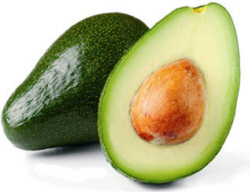
The Fuerte avocado is often recognized as the archetypal avocado, green in color, pear-like in shape, and ranging from six to twelve ounces in size. It has smooth, medium-thin skin that peels easily, with dense, pale green flesh. It is marginally oily with a rich, creamy flavor and notes of hazelnut, and it is still considered by many to be the best tasting avocado. The Fuerte avocado tree is large and spreading, one of the more cold-hardy varieties, and the leaves have a strong anise smell when crushed. The fruit set of the tree is irregular, as some trees never seem to have much fruit while others are productive, and it has a tendency to alternate in bearing, producing an adequate crop every other year, depending on weather at setting time, along with other factors. Avocado trees differ in the types of flowers that they have. Type A have female flowers in the morning and male pollen-producing flowers in the afternoon, and Type B, like the Fuerte avocado, are the opposite. Fruit set in Fuerte avocado trees often improves dramatically when the trees are inter-planted with varieties that have Type A flowers because more pollen is available. When temperatures are less than ideal for fruit set, Fuerte avocado trees may form fruits that are stimulated to grow by the pollen tube but never undergo fertilization, resulting in small, narrow seedless fruit called “cukes”, which may be harvested and sold as cocktail avocados. Unlike most fruits, the avocado does not ripen on the tree and instead begins to ripen once harvested, and their sugar level actually decreases as they mature. Their skin remains green, and the fruit will yield to gentle pressure when ripe.
Haas
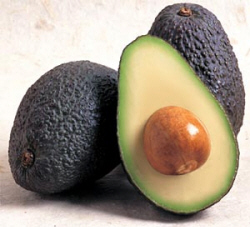
Description/Taste The Hass avocado is known for its quintessentially tumbled leathery fairly thick skin that turns near black when fully mature. The flesh closest to the skin is a lush colored pale lime green and as it nears the central pit it develops a rich creamy yellow tone and softer, oil rich texture. Hass avocado's flavor reflects its texture - creamy and smooth with a nutty and sweet finish. Seasons/Availability Hass avocados' seasons vary depending on the growing region. California avocados are in season from February through October. When they are not in-season, they can be found growing in Chile, Peru and Mexico, though summer Mexican crops have a tendency to have an overly rich oil content. Current Facts Though there are hundreds of varieties of avocados, the Hass avocado has become the benchmark avocado for commercial production. Its long growing seasons, prolific fruit production and shipping tolerance are virtues that make the Hass the standard market avocado. It is the avocado that the general public identify as simply, an avocado. The name avocado comes from the fruits original Aztec name, aoacatl or ahuacatl. After being discovered and mispronounced by the Spanish, and then the English, the fruit made its way to Jamaica where it was called many things including avocado and alligator pear. In Florida the first avocados were introduced by the West Indies as "alligator pears" and was known as such on the eastern coast until The American Pomological Society and the U.S. Department of Agriculture adopted "avocado" as the commercial name for the fruit. Nutritional Value Depending on the time of year, the avocado's fat content varies. In the early part of the harvest season, California avocados have a fat content close to 2 grams per ounce, while later in the year, they can peak at 6 grams per ounce. Avocados are rich in dietary fiber, vitamin B6, vitamin C, vitamin E, potassium and folate and are a good source of mono-unsaturated fat.
Zutano
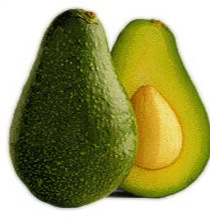
The Zutano avocado resembles the fuerte avocado with its pear shape and thin, glossy green skin, which remains green even when ripe, however its flesh is not as creamy or as rich in flavor. It has low oil but high water content, resulting in a slightly watery flavor, and has pale green flesh with a fibrous texture. Its mild flavor and problematic peeling makes it less desirable than other avocado varieties. The Zutano avocado tree grows upright, with a rounded shape and spreading branches, reaching heights of thirty to forty feet. It has oval dark green leaves with a glossy sheen, and its small flowers are greenish-white in color and they bear in clusters at the branch tips. The Zutano avocado tree produces heavily and is more tolerant of cold weather than other cultivars. The fruits mature to about six inches in length, averaging six to fourteen ounces in weight, and are harvested from mid-autumn to late winter. The avocados must reach full maturity, taking about six months, before they are harvested. However, unlike most fruit, avocados will not ripen on the tree, allowing growers to essentially use the avocado trees as a warehouse for storing fruit for months after maturity.
Ettinger
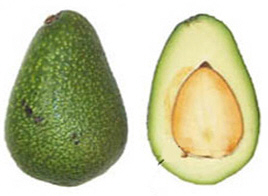
Ettinger avocados are similar to Fuerte avocados, pear-shaped with smooth, thin, bright green skin, which does not peel easily, and pale green flesh. Ettinger avocados have a mild flavor and lower oil content than other varieties, and the fruits average ten to twenty ounces in size. Their inner flesh, like nearly all other types, contains a large seed and cavity, which makes up ten to twenty-five percent of the fruit’s weight. The three main strains of avocados are the Mexican, the West Indian and the Guatemalan, the Ettinger avocado deriving from Mexican and Guatemalan types. The Ettinger avocado tree is very vigorous, and as a heavy bearer of fruit it is often the most profitable variety of many orchards. The tree has an upright growing habit with little spreading, and has the same tendency as the Fuerte variety to sometimes produce seedless fruits, called “cukes”, which may be harvested and sold as Cocktail avocados. Unlike most fruits, the avocado is one of the very few that does not ripen on the tree, and so growers can keep mature fruit on the tree for several months, allowing for greater control of the harvest volume.
Bacon
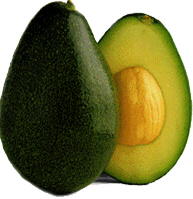
Bacon avocados are oval-shaped and have smooth, thin skin that is dark green in color with faint speckles throughout. Their flesh is pale yellow-green, and it is less oily than Hass avocados but equally as delicious, with a buttery and creamy texture. The central pit in Bacon avocados is large, taking up a substantial amount of flesh in the fruit, and it has a tendency to make the seed cavity mold, making the fruit highly perishable when ripe. The Bacon avocado tree is a medium sized tree with dark green, glossy leaves, and it can reach an average of fifteen to twenty feet in height. It is a late-producing variety with an upright and spreading growing habit, and it yields large amounts of the six to twelve ounce fruit. Avocados are one of the few fruits that do not ripen on the tree, which allows growers to store mature avocados on the tree for several months and have greater control over the harvest volume.
Reed
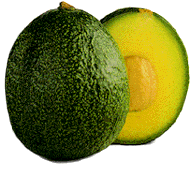
The Reed avocado's most distinguishing characteristic is also an obvious one. It is the largest of all known avocado varieties. Its thin green peel contains a hefty fruit that can easily weigh a pound or more. Its flesh is a pale golden yellow, its weight clinging to its fragile shell. It has a relatively large seed and seed cavity, but its robust size allows it to still carry a substantial amount of edible flesh. Its flavor and texture are both superior in quality. The texture is buttery, almost maintaining a melting quality. Its flavor, bold, rich, nutty and even buttery. Regardless of its obscure commercial availability, it is perhaps the best tasting avocado and considered so among avocado growers. .
Pinkerton

The Pinkerton is a pear-shaped fruit with a tumbled green, easy-to-peel skin. Its flesh is smooth and creamy in texture, rich and nutty in flavor. The Pinkerton avocado is favored for its flavor and small seed-to-flesh ratio and naturally because of its parentage, is often compared to having similar characteristics as a Hass avocado.







